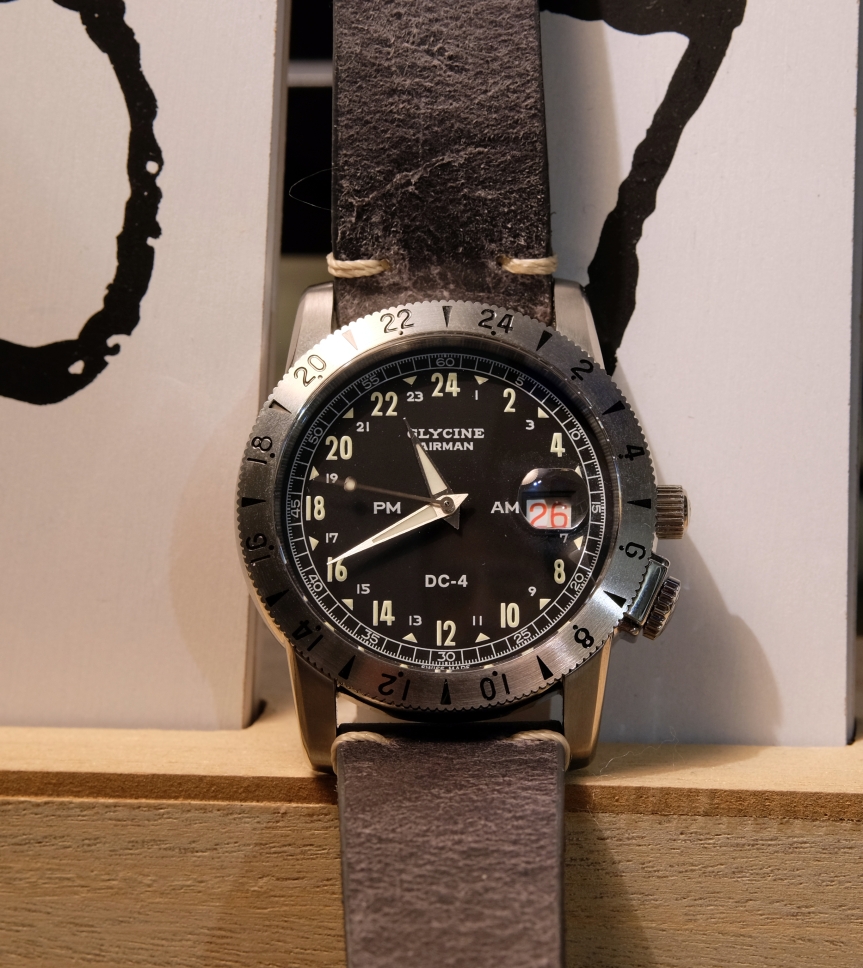
Being from the Top Gun generation, I spent a decent part of my childhood dreaming of being a pilot. This had an impact on my purchases from the earliest days: toy airplanes, followed by model ones, – followed by the inevitable pilot jacket and sunglasses as a teenager. I never had gone as far as buying a pilot watch however as, back in the days, the only one I knew of was the Breitling Navigator. As a teenager / young adult, I had many better places where to place my limited money in.
25 years and a new hobby later, things have changed. My pilot costume finally got itself a watch, in the name of a Glycine Airman DC-4.
I had been eying it online since a while for its retro looks and original 24 hours dial. The fact it houses a Swiss movement made it a perfect compliment for my previously Seiko 6R15 only collection. The Glycine brand was intriguing for being relatively small and off the radar, yet highly regarded in the horology community given its military history. It has lost some of this panache after being purchased by Invicta, but the DC-4 was released prior to this and has a heritage going back all the way to 1953.
I therefore couldn’t resist the temptation when the DC-4 appeared on Massdrop for 600 USD, and clicked on “yes”. 6 weeks of waiting and 150 Euros of custom fees later, the watch was in my hands. After wearing it for about a month, I would like to share my first impressions of it in details here. Let’s get straight into it!
- A bit of history
Glycine was founded by Eugène Meylan, as Swiss watch engineer, in 1914 in Bienne, and initially produced small (miniature) watch movements for ladies’ watches, targeting mainly wealthy people from Europe and America. The brand presented its first self winding watch in 1931, 17 years later.
After the economic depression in the 30s and the second world war, Glycine presented a range of automatic watches in 1945. It was thereby one of the world’s first three companies capable of manufacturing automatic watches on a mass scale, along with Harwood and Autorist.
8 years later, in 1953, the brand presented the first Airman line to the world. The idea came to its creator as he was seated in the first officer seat of a DC-4 from Thai Airways between Bangkok and Calcutta. The pilot spent some time of the flight to explain him the kind of watch every pilot in the world would love to use, and which didn’t exist yet. Within other specifications, it was to have a 24 hours dial as pilots communicate time this way on the radio, and a second time zone to be able to show the GMT, the time of reference used in aviation. After being released, the watch quickly became a favourite within the community of commercial pilots, and of combat pilots during the Vietnam war. The Glycine Airman I am reviewing today is therefore named after the plane where the whole Airman line came to mind.
Some will argue that the first Airman to be produced and sold was the Airman No 1, which has a different dial and hands (pencil vs dauphine) than the DC-4, and no magnifier on the date. Others will argue that, beyond marketing communication from the brand over the No 1, the DC-4 is the original and truly vintage model. The truth probably is somewhere in between, as the Airman line had different models and types of hands when it was first released; pencil hands became uniform to all Airmans in 1955, at the same time as the date magnifier was introduced on the crystals. Today’s DC-4 therefore seems to be a mixture between one of the first Airman model with dauphine hands, and the second generation of Airmans in 1955 because of its magnifier. More than vintage enough for me!
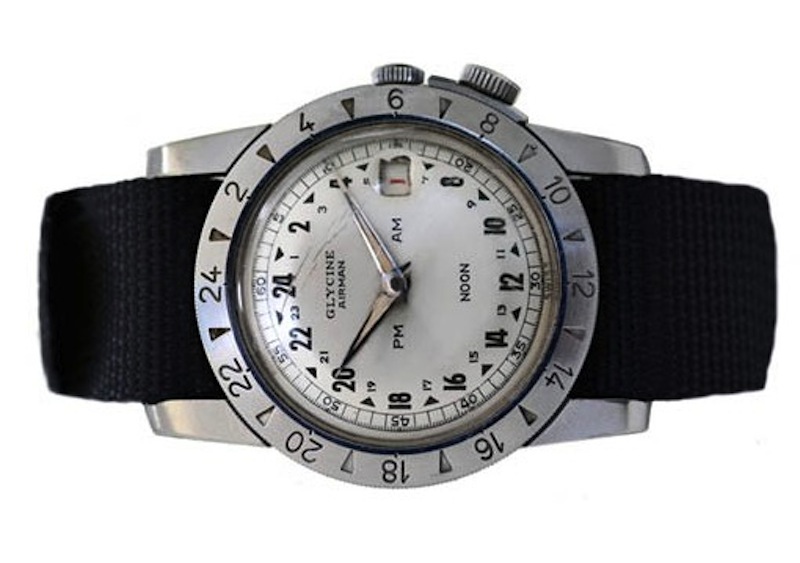
In 1965, an Airman made it to space on the wrist of astronaut Charles Conrad during the mission Gemini 5. He had been wearing an airman since his jet pilot days, and continued wearing it after his space mission.
The brand was acquired by Invicta in 2016, raising fears within the horology community that it would lose its specific taste, quality and style in the process. Invicta repeatedly specified it didn’t want to turn Glycine into an “Invicta bis” and will continue to respect the brand’s philosophy and usual quality.
Something that remains to bee seen as, a few months after the purchase of the brand, many of its models could be found for less than 50% of their MSRP value on the internet. As reference, the MSRP for the DC-4 in January 2017 was 2,900 USD. I purchased the watch in June for 600 USD. Will quality remain sustainable at these totally new and reduced price points? Time will tell, I guess!
- Airman DC-4: case, crowns and bezel
Style and dimensions: I have to start by mentioning that, despite weeks of owning this watch, I am still getting used to it. Strangely not because of its 24h dial which I find relatively straightforward to adapt to, but because of its case and bezel.
All the watches I previously owned, from my Swatches as a kid to the two Seikos I’ve recently purchased, showed attention to integrating the case and dial so that they look like a homogeneous and continuous single piece, which is not the case with the Airman. It’s difficult to explain this with words, so maybe you’ll better understand looking at the picture below that shows these watches side by side.
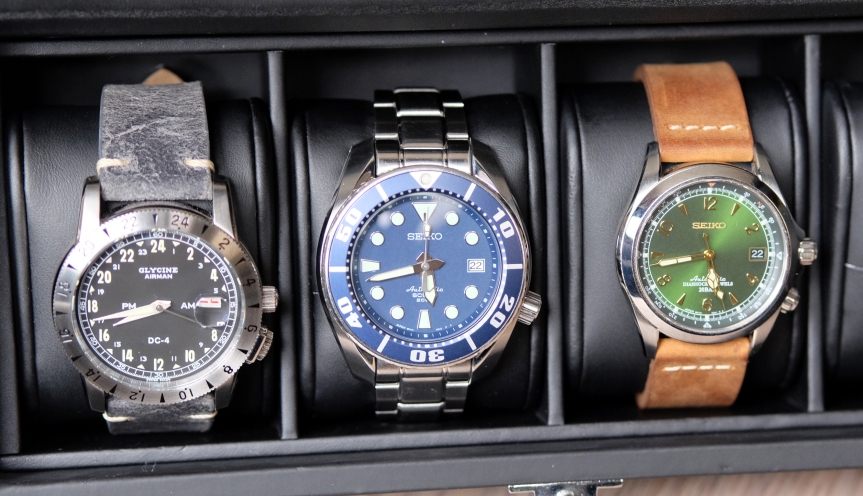
With the Seikos, the case and dial seem to blend naturally. From the top, the Glycine looks like it practically has no case, or like the case itself is irrelevant. The brushed lugs seem to be rudimentary metal bars that have been functionally mended to the case, versus the Seiko where the lugs seem to extend and hug the sides of the dial. All this makes it a very different watch to wear and contemplate; I therefore need more one-one-one time with this baby before getting into my comfort zone.
Things are very different looking at the DC-4 from its sides. Here, one can better see the attention Glycine placed to ensure the shape and placement of the lugs contribute to make the watch more confortable to wear, which is important for smaller wrists like mine as it measures a contemporary 42 mm in diameter.
Thanks to its lug shape, the lug-to-lug distance is of only 50 mm, 2 mm smaller than the Sumo, which itself makes a remarkable job with its 44 mm dial on my 6.7 inch chicken wrist. So I guess this is a good point for the Airman, despite its more rudimentary looks. Last thing to mention is that the side of the case is fully polished, versus the top if its lugs and bezel which are entirely brushed.
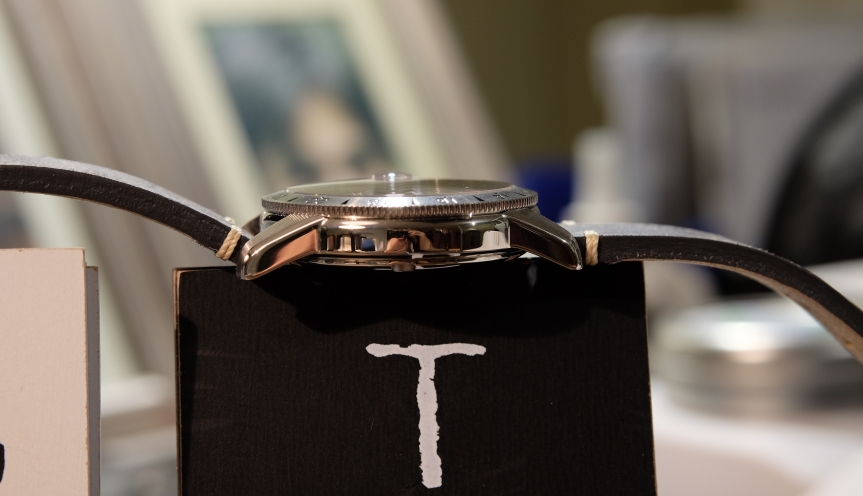
Finishing: I find the overall finishing of the case satisfying, even though the polishing seems somehow lighter than on the Sumo, but it’s only noticeable looking from very close under strong light. The polished sides are very well executed and complement the retro looks of the watch well.
Case-back: The Airman is blessed with a see-through case-back, which remarkably complements my so far all closed backs collection. I have to say I am very pleased with the result at this price point. The back is screwed and polished, with the exception of its “dents” which are brushed. The usual information is lightly engraved on the metal around the mineral glass, which displays a very pretty GL0072 movement, based on a modified ETA 2893-2. The rotor is simply but (I find) exquisitely decorated to remind of the pilot heritage of the watch.
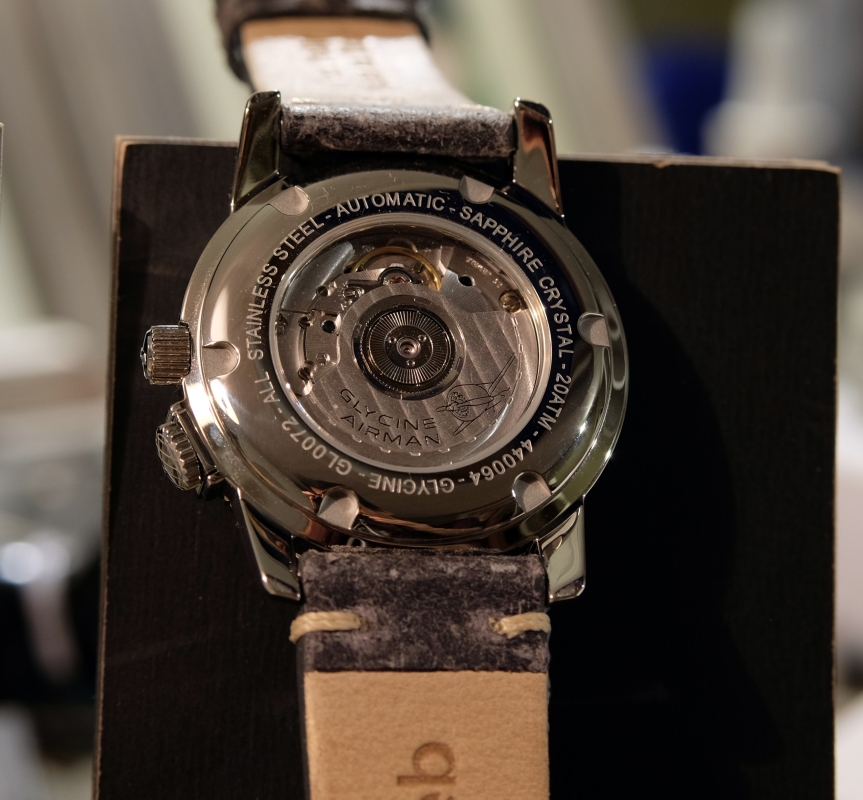
Crowns: The Airman is equipped with 2 crowns: one to manipulate the movement, while the other locks the rotating bezel, in a locking plate system inspired in the 1950s by Glycine’s designers.
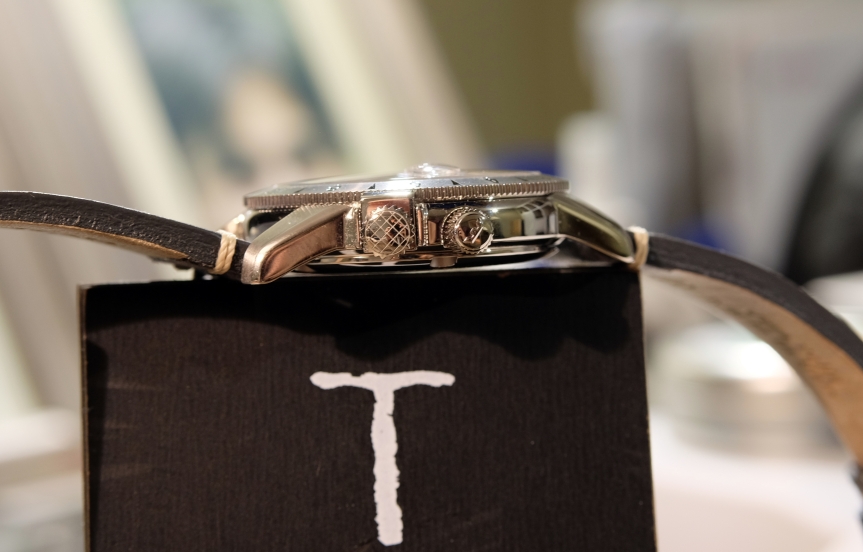
Both crowns are polished in line with the case sides, and very pleasantly decorated. The movement crown is signed by an unaligned when screwed Glycine logo, which appears thankfully only here, and not on the dial, to which we’ll come back later. The bezel’s crown is decorated with engraved lines, in the same style as “petanque” balls, for those who know the French ball game. Not sure if there is a reference to aviation I am missing here, but it’s pleasant enough to the eye.
I have mixed feelings about the locking plate. While it does add a design “complication” to the case, because of its shape it seems once more (after the lugs viewed from the top) to have been added afterwards, rather than elegantly designed with fluidity at the same time as the rest of the case like on the Alpinist. Its shape and the fact that the bezel crown sits short on it doesn’t make its manipulation very pleasant.
Bezel: The Airman comes with a bi-directional rotating bezel marked with 24 hours and used to track a different time zone, giving the Airman a GMT function that is essential to pilots. It also adds to the sportiness of its looks. The bezel is brushed on the top and sides, which are very thin and coined. It’s also one of my main concerns with this watch.
There’s no other way to express it but: “it feels cheap”. To start with, it’s very thin, which somehow makes sense to keep the overall watch at reasonable dimensions, but in return doesn’t give it a very solid feel. This is accentuated by the fact that there is a visible and feelable play to it when the bezel crown is unscrewed – thankfully not once it’s screwed.
The screwing and unscrewing action doesn’t feel pleasant because of the crown shape and its locking plate, and the bezel won’t move until the crown is totally unscrewed. On the opposite, once the bezel is tuned, it won’t lock back before several turns of screwing its crown. Last, the markings on the bezel aren’t engraved deep enough to make them look substantial, I was expecting it deeper engraved from the close-up pictures, particularly the indexes for the uneven hours which are so thin they look like they were just painted. A pity for such an important and visible part of the watch. It’s ok for the price I’ve paid, but I would have been outraged had I paid the MSRP of 2,900 USD for such a bezel!
Case: Conclusion, pros and cons
I’m having headaches trying to give a clear-cut subjective conclusion about the case of this watch, with which I have a love and hate relationship. I bought it because it looked different, because this difference gave it vintage looks I adore, because it would bring a fresh and welcome change in my collection.
And yet, I have problems adapting to some of these reasons which made me want to buy the watch. One of these is the bezel crown and its locking plate, which is not pleasant to manipulate (I’ll comment on the manipulation of the movement crown later).
Also, the very basic shape of the case and lugs when seen from the top (meaning 90% of the time), which contribute greatly to this vintage style I am looking for, isn’t very attractive to the eye that wears it, I spend much less time contemplating the case when wearing the Airman than with my Blumo or Alpinist. Most of the love is for the dial and movement here!
Last, the rotating bezel is a deception to my eyes, even for the reasonable price I’ve paid for the watch. I can’t imagine what the first buyers must have felt when manipulating this bezel for the first time after paying more than 2,000 USD for their DC-4!
This being said, the fact that it’s so different in every angle from what I have owned so far, the pleasant and retro sides of the case and the gorgeous case-back make up for most of those, and push me continuously want to wear the Glycine in order to get used to the flaws I find in it.
Pros:
- Different and original design
- Good case finishing –without being exceptional- at this reduced price point (less than 800 USD). I probably would have found it underwhelming had I purchased it at its previous Glycine price (before the Invicta purchase) of 2000+ USD
- Gorgeous case-back
- Nice visual finishing on the crowns
- Very pleasant sight when looking at the side of the watch
- External bezel giving the watch a GMT function
Cons:
- Very basic case design and integration of lugs. This adds to the retro/vintage look, but also makes the case rather uninteresting to look at from above
- Very thin bezel with lightly engraved markings, making it look cheap
- Play in the bezel when its crown is unscrewed, adding to the cheap feel of it
- Unpleasant action of the bezel crown
- Not very practical crown-lock plate. I understand Glycine had to keep it to stick to the original design of the Airman in 1953, but I have to say other more contemporary bezel action systems have a nicer feel to them.
- Mineral glass case-back. Not a big deal at this reduced price-point, but what was Glycine thinking when selling this watch for 2000+ USD without putting sapphire there?
- Dial, hands and crystal
Mixed feelings about the case then. Will the dial and its 24 hours display make up for this?
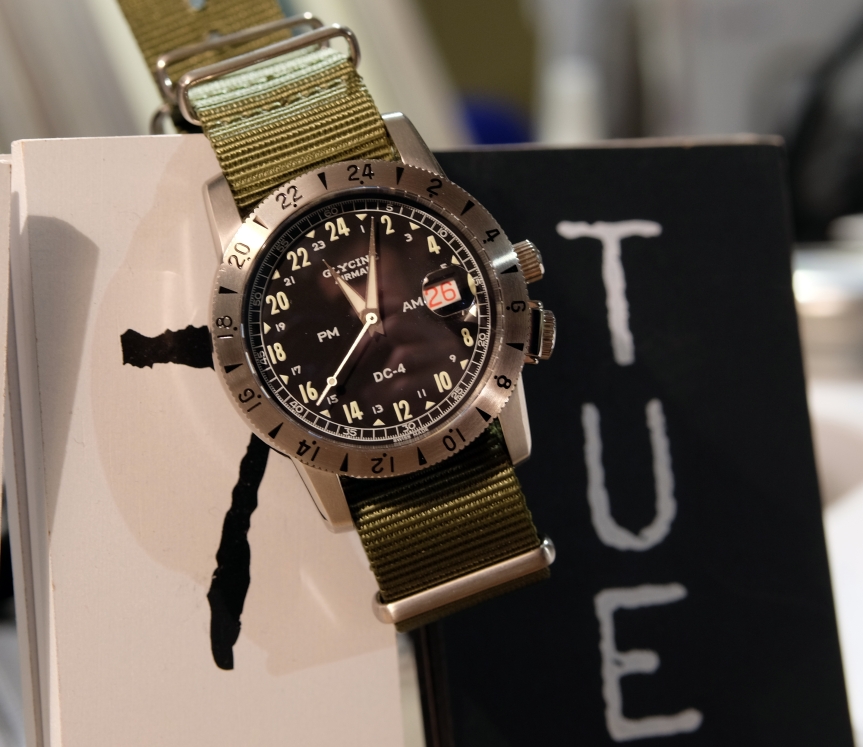
Background: The background of the dial is of a very simple black. I don’t find a different word to describe it than “moderate”: it’s not a deep black, nor a light or greyish one, it’s just plain and mat black. I find this to be in line with the pilot and retro soul of the Glycine, and it adds to its readability.
Markings: Glycine reduced the non index related markings to the minimum on the Airman, which is a welcome move enabling the brand to propose a fully marked 24 hours dial without making it look cluttered.
The top of the dial is marked by a simple GLYCINE, with AIRMAN written in smaller right under. These markings, like all the others, are painted, which helps keeping everything pure and simple in line with the rest of the watch. I don’t miss an applied brand or logo, like I don’t miss it on the Blumo, as it serves its purpose. Speaking about the logo, there is none on the dial, which played a big role in me choosing this model over the numerous other Airman variants available. I like it nice and simple.
PM and AM are written at the middle of the dial, to help users read the time on this original 24h dial. It isn’t essential, I could definitely live without it in terms of looks, but I love the fact it adds to the vintage feel of the watch, as these indications are there since its first version was released in 1953.
A very simple DC-4 is painted at the bottom of the dial. I minimastically love it!
Indexes: The indexes are some of the most interesting parts of this watch, thanks to its 24h dial. I was initially worried that it would be complicated to adapt to this, in between a rotation of watches with a classic 12 hours dial. My personal experience is that the adaptation was very easy, and I don’t struggle switching between the Seikos and the Glycine at all. This being said, I understand this can vary from person to person.
All 24 hours of the indexes are thickly painted in Arabic numerals on the dial, versus applied indexes on other watches. I welcome this once more, as it contributes to keeping things simple despite a large number of information displayed. The fact that all hours are displayed (versus only pairs) contributes to making the time easy to read in this unconventional 24h manner. The pair hours are larger than the impair ones. Last, a railed circle goes around the dial, marked with minutes, again an essential to ensure the readability of the time.
I personally really like this simple and functional dial. Glycine managed to stick a hell lot of information on it without making it look cluttered. This is one of the reasons that made me chose the DC-4 over other Airmans, which I find have busier dials and less vintage feels to them (very subjective of course).
One downside to mention is that the indexes are lumed, but very thinly. This results in much less intensity and durability than for the hands, and means it’s impossible to read the time during the night with the DC-4. The 24 hours dial and no visible indication don’t allow this. Again, a pity on a watch that was initially proposed at this price point, and the Arabic numerals really shine in the dark for the couple of minutes they are alive after charging them with high intensity lights (I’ve never ever seen them charged naturally from ambient light). They would have shined with some Seiko lume there!
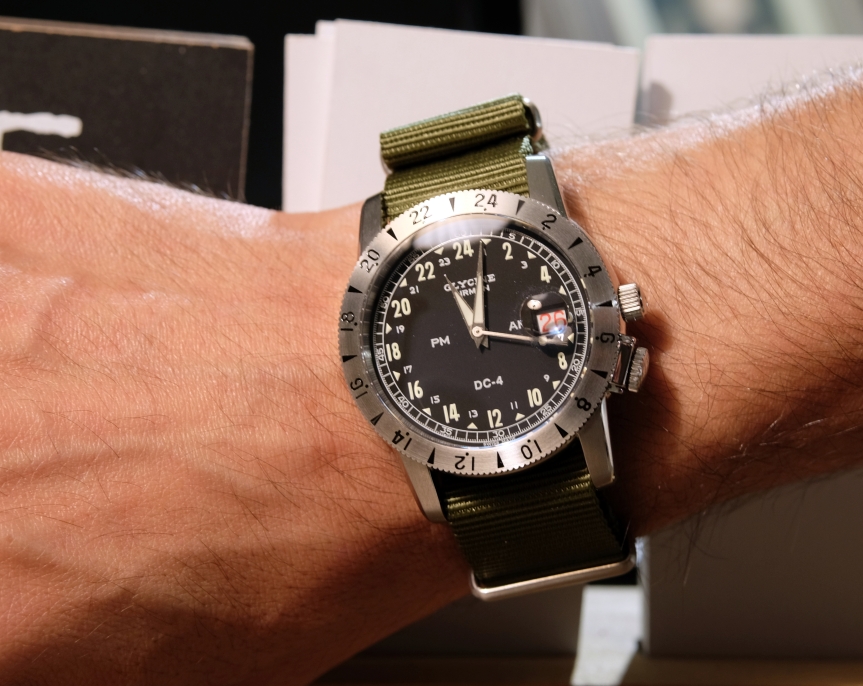
Hands: The hands of the DC-4 are of a very vintage and simple dauphine style. This is not a design that goes with many watches in my opinion, but it’s spot on with the Airman, as I believe they add a tremendous lot to the vintage look of the watch. They are brushed, with a large part covered in lume. The hours’ hand is slightly – it could be more for better readability in an ideal world- thicker and shorter than the minutes one. There is also a syringe seconds hands with no tail at all and a dot of lume, again adding to the retro style of the watch.
The result is visually very pleasant during daytime, even though the relatively small difference between the hours and minutes hands takes some time to adapt to. The lume is generally underwhelming, as only applied on the hands, and terribly outperformed by the Seiko lumes in terms of intensity and durability. This being said, I try to ta take it the positive way and blame it on the vintage looks of the watch, a weak lume perfectly fits that purpose. I know, I try a lot…
One thing to mention is that, because of the 24 hours dial, the hours hand takes time to travel between indexes. In example, it will cross the 14 o’clock index somewhere between 14:10 and 14:15 versus 14:00 sharp, in the same style as Seiko date windows take time to switch around midnight. It’s not a big deal in everyday’s use and entirely linked to the 24 hours dial (and not some QC issue), but worth mentioning as I found it surprising when I fist saw it, and had to check on the internet to make sure there wasn’t an issue with my unit.
Date window: The Airman’s movement has a date complication which is very ostensibly displayed on the dial, thanks to its (quite effective) magnifier and red font.
This was a lot of novelty to digest for me: this is my first watch with a magnifier, and I tend to like my date complications as invisible as possible – One of the reasons I adore my Seiko Alpinist so much!
So I have to say I initially hated everything of this date window. “Why a magnifier? The date window looks so cute looking at it sideways without it!”, or “why on earth is the date marked in red, a colour that comes out of nowhere with the rest of the watch?”. I was also worried that the magnifier would make it difficult to read the time between 5 and 7 am, but it doesn’t really. I even thought or removing it, then backed out as it would seriously reduce its resell value in case I want to flip it.
Then I tried to understand things. I’m speculating here, but I guess the ability to easily read the date is important to pilots, hence the accent placed on it. I also learnt to grow used to it, accepting the fact that the magnifier adds to the retro looks of the watch. I’m not sure I got over that red font yet, but I’m slowly getting there. I think…
Crystal: The Airman comes with a sapphire crystal with triple anti-reflective coating. This is welcomed as the crystal is slightly domed, and would attract lots of reflection without it (something the magnifier does a lot, the AR coating not working on it!).
The AR coating is effective in most situations, but the dome somehow reduces this effect. As a result, in very high and reflective lighted environments, I feel my Alpinist reads better despite its lack of coating, thanks to its flat crystal and golden indexes that reflect the light more than any other reflection.
I also have to mention a small worry here: after o few days of wear, I noticed that my crystal either has a small bang on it, or has a small particle of dust under it, I haven’t figured which is the case yet. Either way, a little underwhelming on this new watch, considering it took me more than 6 months to have my first tiny bang on the Blumo’s hardlex crystal.
Conclusion on dial, hands and date window
In conclusion to this section, I really like the way Glycine proposed a dial that is identical to the initial watch released in 1953, and how it pulled out showing so many information on a relatively simple end-result. While I have some stylistic reservations on the date window, I prefer it this way than a more visually pleasing and less conform to the original one. I’m really looking forward to see how all this is going to age, with all markers being painted versus applied. A true and perfect wannabe vintage!
Pros:
- 24 hours dial, a great change and addition to any collection!
- Simple and uncluttered dial despite a lot of information displayed
- No Glycine logo
- Screams “vintage” and “retro”
- Easy to read despite an unconventional index
- Seems to me that the mat and simple finishing will age very well, the watch begs to be bruised by time a little!
- Pretty and well executed vintage hands
- Seconds hand that beautifully sweeps at 28,800 vpm… a welcome change from my Seikos!
- Sapphire crystal with triple AR coating on the inside
Cons:
- Magnifier on the date, took me some time to get used to it, I guess some never will.
- Red font for the date… Why???
- Very light/poor lume on the indexes, making the watch impossible to read at night – well, only during a couple of minutes after specifically charging the lume to be precise.
- Average lume intensity and durability on the hands – which is not a huge deal as without seing indexes this would be useless on a 24 hours dial anyway!
- The magnifier attracts a lot of reflection, negatively balancing the A R coating of the crystal in terms of readability of the time under certain lights.
- The hours hand takes some time to cross the hours indexes
- Movement
The movement present in this watch is one of the reasons that triggered my purchase. My two previous automatic watches are equipped with a Seiko 6R15, and I wanted to taste something different. The GL0072, which actually is a slightly customized ETA 2893-2, was perfect for this.
ETA 28-93: The main characteristics of the 28-93, which was designed in the 70s, are its 24 hour hand or GMT function, 28,800 vph, 21 jewels, hacking and winding, date complication, ETACHRON regulator system and regulator corrector, 42 hours of power reserve, rhodium coated.
This is a workhorse movement used in many watches considered as more prestigious than the Glycine, such as the Hamilton Jazzmaster GMT, the Sinn Mission Timer, the Panerai Luminor GMT, Steinhart GMT Ocean 1. Modified versions of this movement can also be found in several IWC (calibers 37526 and 35720), most Breitling GMT models (caliber B32), the Mont Blanc Timewalker GMT (caliber MB 24.05) and GMT models from Bell & Ross (caliber BR-CAL.303).
This doesn’t of course mean that the Glycine has the exact same movement as a Panerai Luminor GMT. Each ETA movement comes in 4 different finishing which impact both its looks and performance (notably durability). It’s difficult to differentiate one finishing from the other, but I would bet that Glycine uses the basic version, and Panerai a more elaborate one. Still, the basics are the same, and I have a feeling that the Airman offers this highly regarded movement at a fair price with its current positioning.
Accuracy: I don’t know if Glycine regulates its movements before shipping them, but mine came very accurate, losing slightly more than 2 seconds per day after a month of wearing it. For comparison, my Alpinist runs at +2/3 seconds per day, while my Blumo came at a miserable -20 seconds per day.
Decoration: I have to praise Glycine for the decoration work they did on the movement of a watch at this price point. It isn’t abundant, but very pleasant to look at, in particular the rotor that reminds of the aviation heritage of this timepiece.
Date complication: Another very pleasant surprise that came with this watch is its quickset date change: it clicks in less than a second at midnight, versus the 6R15 date changing which takes about 2 hours to be complete. It may be a detail, but it’s a very nice one to have none the less!
Manipulation and winding: As with the rest of the watch, I do have some reservations about the movement of the Glycine however, mainly related to its day to day handling.
My main issue is with the way the crown unscrews on my Airman. While with my Seikos, the crown clearly “jumps” or “clicks” on a spring when unscrewed, the Glycine sometime misses this and directly unscrews to the date change position, with no transition whatsoever. When this happens, I end up changing the date by mistake, and have to change it 30 more times to put it back on track. A bugger! I hope it will happen less with time as the crown settles in, let’s see. I also don’t know if this is the case with all DC-4s or just mine.
Another small let down I have about this movement is the not-so-great feeling when hand winding it. My reference is the Blumo, which is an absolute joy to smoothly wind… to the point I sometime do it for pleasure only! The GL0072 offers sensibly more resistance when winding, and doesn’t “feel” smooth at all, even less than the Alpinist, which sits a notch below the Blumo. Again, I don’t know if this is the case with all Airman DC-4s or just an issue with the crown on mine, as the ETA 2893-2 is known to wind like butter.
The last negative point related to this watche’s movement and action is that its crown is relatively small, and somehow stuck behind the rotating bezel crown guard. Again, this impacts negatively on the feel when winding or setting the time.
To conclude, I overall have pleasant feelings about this movement, and see it as a welcomed addition to my recently started watch collection. It’s precise, proved to be a workhorse over the years, has reasonable maintenance costs, and fills for a tremendous value several gaps in my collection such as the 28,800 vph, the 24 hours dial and the date change in a click. This is enough to ensure I’ll get over the small cons I’ve highlighted above.
Pros:
- Known and tested Swiss movement present in many more expensive and regarded watches
- Good accuracy
- Interesting complication with the 24 hours’ dial
- Fast date changing
- Reasonable servicing costs
- 28,800 vph giving it a smoother sweep than on my Seikos
- Decent power reserve
- Very nice, albeit simple, decoration of the rotor
Cons
- Unscrew click not always working resulting in accidental date change (probably specific to my unit)
- Not very smooth winding action compared to my Blumo and even my Alpinist – could be specific to my unit
- Small crown somehow stuck behind the bezel crown guard
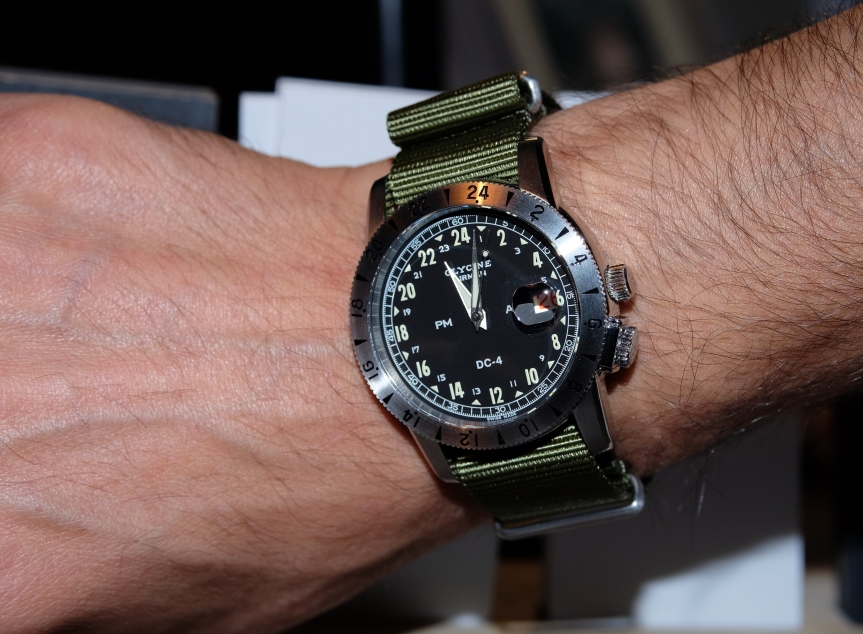
- Strap, value for money and conclusion
Strap: The Airman DC-4 comes on a very nice black NATO strap. It breathes quality, is thick enough to be comfortable to wear, and has very nice hardware (round and brushed) which perfectly fits the overall vintage/retro image the watch reflects. I may not wear it often though, as it makes the watch sit higher than on a strap, and looks bigger on the wrist. The relatively long lugs of the Airman are on the limit for my 6.7 inch chicken wrist, so I’ve purchased a new dress, a vintage Colareb, for this darling. I have to say I dig the way this combination looks much more than on a NATO. Question of taste of course, so please feel free to let me know what combination you think looks best in the comments section.
I had very mixed feelings about the Airman DC-4 when opening its package. While I liked its overall looks – no surprise compared to pictures here-, I was somehow turned down by the rotating bezel and action quality, and by the small issues I found manipulating the movement crown. I even started wondering whether I should flip it or not. The negative perspective I had was further intensified after breaking a spring bar when changing its strap for the 5th or 6th time only, one week after receiving it. Were my expectations too high, given the initial MSRP of this watch?
I started to have a bad feeling with the name “Invicta” echoing in the background. Is this watch really exactly the same as before Glycine was purchased? I looked at older reviews of it and found at least one notable difference: its lugs used to be drilled last year, they aren’t anymore. Is there other notable differences that Invicta is not communicating on, in order not to ruin the reputation of its newly acquired brand? I find this hard to affirm one way or the other. So I decided to spend some time with the Airman before drawing conclusions, to see if it grew on me.
I have to say it did. I gradually got used to the rugged and minimalistic design of its case, to its long lugs, even to its date magnifier! I grew fond of its retro looks, its beautiful see-through case back and ETA movement, its 24 hours dial. The only things I didn’t get used to (yet, hopefully, think I’m slowly getting there) are its cheap feeling rotating bezel and the red font used on the date display.
This is hardly enough for me to consider flipping it in the short term, particularly as this single timepiece fills so many previously existing gaps in my collection. Before owning the Glycine, I didn’t have:
- A Swiss automatic watch (overall)
- An ETA movement
- A 24 hours dial
- A quick changing date
- A see-through case back
- A GMT function, even though in its most basic possible implementation
- 28,800 vph
- A pilot watch
- A retro looking watch
- A date magnifier (like it or not, has to be one in a collection I guess!)
- A black dial
Ticking so many boxes at once, I feel the Airman DC-4 represents tremendous added value to my collection. Considering the reduced price I have paid for it on Massdrop – 600 USD + import taxes -, I find it to be very reasonable, and I would put its value for money somehow on par with my Blumo – even though the later feels more substantial on the wrist.
After some initial reservations, I am therefore growing fond of the Glycine and will stick to it for at least a while. This satisfaction would however been totally different had I paid more than 1,000 USD for the watch, and the negative experience with the bezel will probably prevent me from buying the Combat Sub in the future, a model that previously was on my radar. I already have an exquisite dive watch in the Blumo, now own a Swiss watch with an ETA movement, so I wouldn’t be able to compromise with such perceived quality (maybe it is of quality, but if it doesn’t feel like it, where’s the fun?) issues on a Sub.
I hope this review helped people who have an eye on the Airman and a finger on the trigger. I personally don’t regret my purchase, but had to live with some compromises for it. Make your decision in accordance, don’t hesitate to comment on this review or ask further questions below, it will be my pleasure to answer best I can. Have a gentry rest of week – small wink to TGV, the person who probably influenced me most into liking horology.
Edit: In the end, I didn’t manage to adapt to this watch. It’s therefore for sell under these terms:
- Watch with box, papers and original NATO. Watch was very little worn and mostly on a NATO so no scratches or dings to report
- One Colareb vintage dark grey strap (the one in this review)
- 3 Strapcode NATOs: one BOND (black/grey, lightly worn), one Khaki and one light grey – unworn.
Import taxes paid for Europe, ships from Belgium. 500 Euros.
Contact me if interested. Thanks!

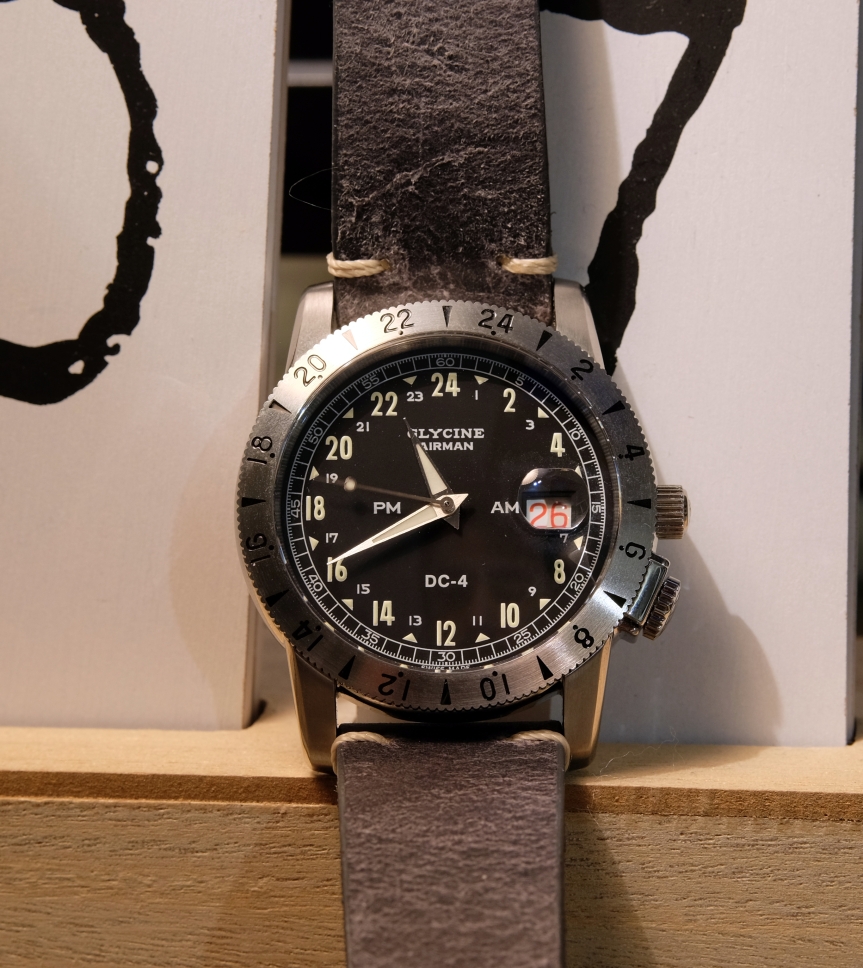
Hi everyone! A reader mentioned that the Airman actually doesn’t have a bezel crown guard, but rather a small extension into which the crown screws down to lock and unlock the bezel. I have to say he is absolutely right in saying this system doesn’t protect the crown, hence shouldn’t be called a guard. apologies for this mistake in the review!
LikeLike
Just received my DC-4 today from Glycine-Direct on eBay for $624.99, free 2 day shipping, 2 yr warranty. I have multiple watches that are in the 2-4k range and I already enjoy this one as much. Love the high beet ticking, hand wind capability, being able to use the GMT hand as a compass while camping…This can either be an everyday office watch or a tool watch. The size is perfect and I have it on a stitched handmade tan NOSTIME (eBay) leather strap for work and have a crown and buckle NATO for outdoors. The bezel does move differently than I thought it would and the arrows could be engraved a bit deeper for sure. I also noticed that the GMT hand doesn’t click as fluently as I would like as it will jump around a bit on mine at least. Have to remember to change it slowly and deliberately I guess. Also wish the lugs were drilled but it does have quality spring bars that are very easy to change out. At this price it’s a no brainer.
LikeLike
Thanks for your impressions Will. It seems we agree on most points, even though I can’t comment on the GMT hand as I own the Purist, so it’s great you’ve added this to the comments section, once again, thanks! I’m also glad you’ve had a better experience than me with your spring bars, I guess the one that broke on mine was a bad apple. Enjoy your watch as I’m enjoying mine – I’m actually wearing it right now-. I’m worried it will lose some wrist time once I’ll receive the Stowa flieger I’ve just ordered though. Let’s see, I’ll make a comparison of those two very different yet both pilot watches! 😉
LikeLike
I just received my 0072 yesterday. Nice review! I agree with most all of the above review. My initial impressions are that this is a very beautiful watch for the price (I paid ~700 though Jomashop). I was also confused by the crown initially – it is easy to skip past the position 1 (winding) and end up in position 2 (date), but now that I know how it works it is pretty user friendly and the winding is very smooth on mine. Odd thatb the directions do not say how to wind it. Don’t pull out on the crown to get to position 1, just gently unscrew and you will feel it kind of smoothly relax into position 1 although there is not a distinct obvious “click” or otherwise to let you know. Similar to the reviewer, I was saddened that the numbers do not glow at night as they should – huge bummer in my opinion. The hands do, but what good is that if you can’t see what they point to? I back of the watch is cool. The face of thew watch is really nice fir the price (I had been looking for a vintage for a long time but could not find oine at a reasonable price that was not beaten up so was thrilled when they did this re-make. The black NATO band it comes with is much higher quality than I expected – so that is a nice surprise. Very comfortable to wear. My wife thinks it is gorgeous. I love this watch for the price. It is so cool. Not perfect, but really cool nonetheless.
LikeLike
Thank you for your comment! About the crown, I think mine has a problem, however softly I handle it, 2 times out of 3 it will unscrew straight in the second position. I’ve just learnt to live with it, and will have it checked at its first service, if it survives in my collection until then.
I still like and wear it a lot but have just received the Stowa Flieger I had ordered – well it arrived at my parents in Belgium, am still to put my hands on it. That’s going to make 2 black dialed pilot watches in my collection, so I am expecting one of the 2 to get flipped at some point, possibly to buy an SARB033 and a Sea-Gull 1963 in replacement. I still like my DC-4 a lot but after having bought 4 watches in one year, I’ve reached a point where I need to stop spending and flip one to get some more. I’m yet to see the Stowa but quality wise it should be a step up (top grade ETA, blued hands, hand brushed case…) so the DC-4 is likely to be that one. We’ll see in a few weeks I guess. Enjoy your watch in the meantime, using that 24h dial for the first time sure is a thrill!!
LikeLike
agree. it is kind of fun to read the 24 hour dial. Requires a bit of deliberate thought when reading the watch which is kind of nice. Sounds like you have a pretty good collection underway. Enjoy!
LikeLike
I wonder the difference between gl0071 and gl0218
After a hard search, 0071 explains that the 21 stone 0218 is 25 stone.
I wonder why the two watches look the same and the price is different.
I want you to help me. Thank you.
LikeLike
Hello! From what I see, the GL0218 has a 12 hours dial and a GMT hand, meaning the hours hand makes one full rotation every 12 hours, and you have a separate GMT hand, which is a different tweak of the same movement, and which requires the extra 3 jewels. The GL0071 reviewed here is the “purist” version with a 24h dial, meaning the hours hand will do one full rotation in 24 hours, which is a different complication that requires less jewels. Other than that, the watches are the same, and should be the same price depending on which website you look at. You therefore need to chose between a 24h dial, or a 12h dial + GMT hand, which should be easy enough as they are so different one from another 😉
LikeLike
The movement GL293 could be based on the ETA 2893-2 (21 jewels) or the Sellita 330 (25 jewels).
These movements are used in both the GMT and the “Purist” Airman watches.
LikeLike
The pics are for the GL0072 BTW without the GMT hand BTW!
LikeLike